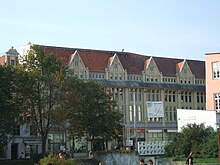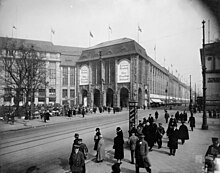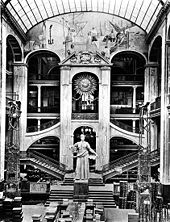Wertheim Group

The Wertheim Group was a department store - Group family Wertheim , which has its origins in the city of Stralsund had. The expanding, significant group was expropriated by the National Socialists and re-established after the Second World War . In the mid-1980s, the brand was taken over by Hertie and this group was again taken over by Karstadt in 1994 .
history
On April 15, 1852, the brothers Abraham Wertheim (1819-1896) and Theodor Wertheim, who came from Anklam and who had gained professional experience in Great Britain from 1841-1851 , opened their "Manufactur fashion store" in Stralsund's Wasserstraße . In 1875 Abraham and Ida Wertheim's (née Wolff, 1830–1918) first department store in Wertheim, a small haberdashery shop in the form of a corner shop ( Mönch- / Mühlenstraße ), also in Stralsund. In 1876 the sons of Abraham Wertheim, Georg and Hugo, joined the business and expanded the product range. They brought the experience they had gained during their training in Berlin to the business. The innovations included the right to exchange and the possibility of viewing the goods carefully before buying them. Uniform prices for all social classes were another innovation. In 1879 employees were employed for the first time, and in 1880 the business was relocated to larger premises.
In 1884 the first branch was opened in Rostock . In 1885 Georg Wertheim opened the first branch of the manufactured goods shop in Berlin with his brothers Franz, Wilhelm and Wolf . In 1894 the first department store with freely displayed goods and fixed prices was opened in Kreuzberg's Oranienstrasse . It counts as the head office of the Wertheim department store group. Department stores soon followed on Moritzplatz and Königstrasse . In 1897 the later known building complex of the Wertheim department store on Leipziger Strasse , designed by the Berlin architect Alfred Messel (1896), was inaugurated. The department store was expanded over the years to Leipziger Platz and was the largest department store in Europe at the time with a floor space of 106,000 m². In 1902 the Wertheims in Stralsund acquired the properties at Ossenreyerstraße 8-10 and had a large department store built there, which opened in 1903. In 1927, the neighboring properties at Ossenreyerstraße 11 and 12 came into their own, and extensions to the department store were built on them. In 1905, another department store of the Wertheims opened at Rosenthaler Strasse 27 in Berlin-Mitte, also by Alfred Messel.
On the occasion of the opening of the Reichstag on October 13, 1930 , supporters of the NSDAP attacked the Wertheim department store.
After the “ seizure of power ” by the National Socialists, there was a boycott of Jewish businesses. In 1934 Georg Wertheim donated his entire fortune to his non-Jewish wife Ursula. Nevertheless, the Wertheim company was classified as "purely Jewish " in 1935 . 1937 came the expropriation by the National Socialists. All Jewish managers were fired. The department stores of Hermann Tietz became Hertie , those of his cousin Leonhard Tietz Kaufhof , the department stores of Schocken Merkur , and Wertheim became AWAG (Allgemeine Warenhaus Gesellschaft AG). In 1944 the house on Leipziger Strasse was destroyed by Allied air raids . After the end of the Second World War , with the division of Germany , the houses were taken over by the Soviet occupying forces and later became public property, with the exception of the house on Moritzplatz in the American sector in West Berlin . From 1949 the Stralsund house belonged to the consumer trade association .
Wertheim AG started a new beginning in 1952 with a small shop on Wilmersdorfer Straße . In the same year the new building on Schloßstraße followed and in 1971 the house on Kurfürstendamm . In the mid-1980s, Wertheim was then taken over by the Hertie Group. From 1994 Hertie also belonged to Karstadt . In Berlin, two department stores had the Wertheim name until April 2009 . Then the brand disappeared completely from the cityscape in Berlin.
Litigation
For several years, legal disputes about return claims were conducted by and between the Wertheim family, the then KarstadtQuelle AG (today: Arcandor ) and the State of Berlin over the valuable properties located in the former East Berlin and not subject to the old compensation regulation of the post-war period had fallen. On 13 October 2005, the trial of failed KarstadtQuelle to reach the state of Berlin, the retransmission of the land, finally, as the Federal Administrative Court , the revision against to an adverse judgment of the Administrative Court of Berlin did not allow. On October 24, 2005, the family's lawsuit in the Pennsylvania Court of Appeals was denied. As a result, the trial in the USA was not permitted.
On March 30, 2007, the KarstadtQuelle Group announced that it would compensate the heirs of the “Jewish” Wertheim merchant family, expropriated by the National Socialists, with EUR 88 million. The group announced that an out-of-court settlement had been reached with the Jewish Claims Conference . The intention is to also support Holocaust survivors around the world.
Wertheim department stores


- Stralsund (1875; shop, new building 1903/1904, extension 1927/1928, expropriated in 1948, HO -Warenhaus Konsument , 1991 Horten-Konsument , closed in 1996, many years of renovation under various owners until 2002, since 2008 department store Jesske )
- Rostock (1881; shop, new building in 1903, closed in 1945, Hertie after 1991 , closed in 1995, demolished in 2000)
- Berlin , Rosenthaler Straße (1885 first fashion goods store, new building as a department store 1903–1905), today AOK Federal Association
- Berlin, Oranienstrasse (1894–1913)
- Berlin, Oranienburger Strasse (1909–1914, today: Kunsthaus Tacheles )
- Berlin, Leipziger Strasse (1897–1944)
- Berlin, Columbushaus at Potsdamer Platz (1945–1948)
- Berlin, Moritzplatz (new building, 1913–1945)
- Berlin, Königstrasse (new building, 1911–1945)
- Berlin, Schloßstraße (new building, 1952–2009, has been rebuilt)
- Berlin, Kurfürstendamm (new building, 1971–2008) conversion to Karstadt
- Bochum (1958–1986, completely rebuilt in 1988/1989)
- Breslau , Schweidnitzer Straße (new building, 1930–1944, today: Renoma department store ; for the Wertheim department store, see Wertheim department store (Breslau) )
- Essen , Kettwiger Strasse (new building, 1964–1986)
- Essen-Steele (new building, 1972–1979)
- Hanover , Kröpcke-Center (new building, closed on March 11, 1981)
- Hanover, Raschplatz (new building, closed on June 30, 1979)
- Kaiserslautern , Stiftsplatz (closed)
Wertheim Leipziger Strasse (Berlin)

The Wertheim Leipziger Straße , later also called Wertheim Leipziger Platz , was called the most beautiful department store in Germany. The house was in competition with the Tietz department store on Alexanderplatz (started in 1904) and the later KaDeWe ( Kaufhaus des Westens ) on Wittenbergplatz . The department store founders Rudolph Karstadt , Adolf Jandorf , Hermann Tietz and Georg Wertheim brought the American invention of the large department store to Germany in the 1850s.
The Wertheim House on Leipziger Platz was built between 1896 and 1906 (1st to 3rd construction phase) according to plans by Alfred Messel ; the fourth construction phase (1911/1912) came from Heinrich Schweitzer . The 27,000 m² property area of the department store reached down to Vossstrasse . The Imperial Majolica Manufactory Cadinen supplied building ceramics for the extension ; the tiles adorned the walls and fountains of the summer garden; Kaiser Wilhelm II came to the inauguration . A fifth construction phase by Eugen Schmohl and Paul Kolb followed in 1925/1926. The main front on Leipziger Strasse was 240 meters long, with an additional 90 meters on Leipziger Platz . The house surpassed all previous German department stores and was the largest department store in Europe with 112,000 m² of usable space and 70,000 m² of sales area . The KaDeWe (1920: 24,000 m², 2008 approx. 61,000 m²) and the Harrods department store in London (62,705 m²) are similar in size . The Allied air raids of the Wertheim complex end of January 1944, partially destroyed. The building stock was sufficient to restore it after the Second World War, but the Wertheim houses in what was then the eastern sector of Berlin were expropriated. The ruin was torn down in 1955/1956.
In the former vaults in the basement of the department store as well as in two rooms on the ground floor of the building which was located from 1991 until complete demolition mid-2005 Techno -Club Tresor . The LP12 Mall of Berlin , which opened in September 2014, was built on the site .
Wertheim Schlossstrasse (Berlin)
As early as the 1920s, G. Wertheim acquired a 30,000 m² property on the corner of Schloß- and Treitschkestrasse in Berlin-Steglitz . It reached down to Lepsiusstrasse. It was only after the Second World War that this department store, which was also the first post-war department store in Berlin, located on the corner of Steglitzer Schloßstraße and Treitschkestraße, was built between 1950 and 1952 as a four-story new building.
In 1969, a five-storey extension was built on the corner of Schloßstrasse and Schildhornstrasse in a style that was modern at the time (lamella facade). The existing house was also redesigned with this facade cladding. A multi-storey car park was built on Schildhornstrasse, following the extension . The publicly accessible Harry-Bresslau-Park is located on the large Wertheim property behind the department store . The adjacent Karstadt department store was completely renovated and rebuilt in 2007–2009. The Wertheim department store remained in operation during the roughly two-year construction period of the Karstadt store. For the opening of the new Karstadt store on April 2, 2009, the Wertheim department store was closed on March 27, 2009. On the site of the Wertheim-Haus (Schloß-, Schildhorn-, Treitschkestrasse), the second largest shopping center in the city, the Boulevard Berlin , opened on April 4, 2012 with around 76,000 m² . Work on this project started in May 2010. The original facade of the building from 1952, which is a listed building, has been restored and integrated into the new building.
Wertheim Kurfürstendamm (Berlin)
The Wertheim department store on Kurfürstendamm was built from 1969 to 1971. In the 1980s, the department store was redesigned with an extension of the facade. After KaDeWe and Karstadt on Hermannplatz, the store is the third largest department store of Karstadt Warenhaus GmbH in Berlin. It is located at the central point of Kurfürstendamm near Breitscheidplatz and the Gedächtniskirche . The property extends over an area enclosed by Kurfürstendamm, Augsburger and Rankestrasse . This Wertheim house has a usable area of 33,000 m² and a sales area of 28,500 m² on eight floors.
During the renovation of the Arcandor - Group should this - as well as other Karstadt stores in Dusseldorf , Essen , Munich , etc. (among other things also Hertie in Munich and the Alsterhaus in Hamburg ) - are classified in a more upscale category, with a buyers guide for KaDeWe . So far, however, there has been no promotion to the Karstadt Premium Group . Instead, the name was changed to Karstadt in October 2008, combined with a redesign and redesign of individual sales areas. The company justified the change of name with the adopted "one-brand strategy" and the savings in advertising costs. The name Wertheim has since disappeared from the Kurfürstendamm.
literature
- Erica Fischer, Simone Ladwig-Winters: The Wertheims. Story of a family. 2nd edition, Rowohlt, Reinbek 2008, ISBN 978-3-499-62292-2 .
- Simone Ladwig-Winters: Wertheim. A department store company and its owners. Example of the development of Berlin department stores up to "Aryanization". (= Adaptation, self-assertion, resistance , volume 8.) LIT, Münster 1997, ISBN 3-8258-3062-4 . (also dissertation , Free University Berlin , Berlin 1996)
Web links
- Helmut Frei: Brown shadows in the heart of Berlin. Karstadt and the Lehrstück Wertheim . SWR , September 29, 2006 ( mp3 , 37.6 MB) (with original soundtrack Ladwig-Winters) , manuscript ( rtf , 43.2 kB)
- Schloßstraße: Karstadt is renewing itself. New premium department store and demolition of Wertheim . In: Der Tagesspiegel , February 15, 2007
- Jochen P. Ziegelmann: Wertheim department store . Potsdamer-Platz.org, April 1, 2009 (Wertheim am Leipziger Platz: Traces of Destruction)
- Christoph Neubauer: 3D animation of the Wertheim in Vossstrasse
- Website of the Association for the Promotion of Historic Department Stores Wertheim and Tietz in Stralsund e. V.
- Alfred Messel : The Wertheim Building. Details of its facades and its interiors, as well as plan and cross-section . Berlin, 1899. Digitization: Central and State Library Berlin, 2018.
Individual evidence
-
↑ Architectural monument Rosenthaler Straße 31: Wertheim department store , accessed on April 15, 2017.
Half-page furniture advertisement for the Berlin Wertheim houses in the Vossische Zeitung , October 20, 1928, accessed on April 15, 2017. - ↑ Andreas Wirsching , From World War to Civil War? Political extremism in Germany and France 1918–1933 / 39. Berlin and Paris in comparison , Oldenbourg, Munich 1999, p. 463.
- ^ Nils-Viktor Sorge: Karstadt-Quelle compensates Wertheim heirs. In: Der Tagesspiegel , March 31, 2007, accessed on April 15, 2017.
- ^ Wertheim department store, Rosenthaler Strasse. In: arch INFORM ; Retrieved November 30, 2009.
- ^ Wertheim department store, Moritzplatz / Oranienstraße. In: arch INFORM ; Retrieved November 30, 2009.
- ^ Wertheim department store, Leipziger Strasse. In: arch INFORM ; Retrieved November 30, 2009.
- ^ Karstadt department store, formerly Wertheim am Kurfürstendamm . District Office Charlottenburg-Wilmersdorf, accessed on April 15, 2017.
-
↑ Wertheim am Kurfürstendamm is now called Karstadt. In: Die Welt , August 22, 2008, accessed on April 15, 2017.
Katrin Lange: Wertheim has disappeared from the Kudamm. In: Berliner Morgenpost , October 4, 2008, accessed on April 15, 2017.



